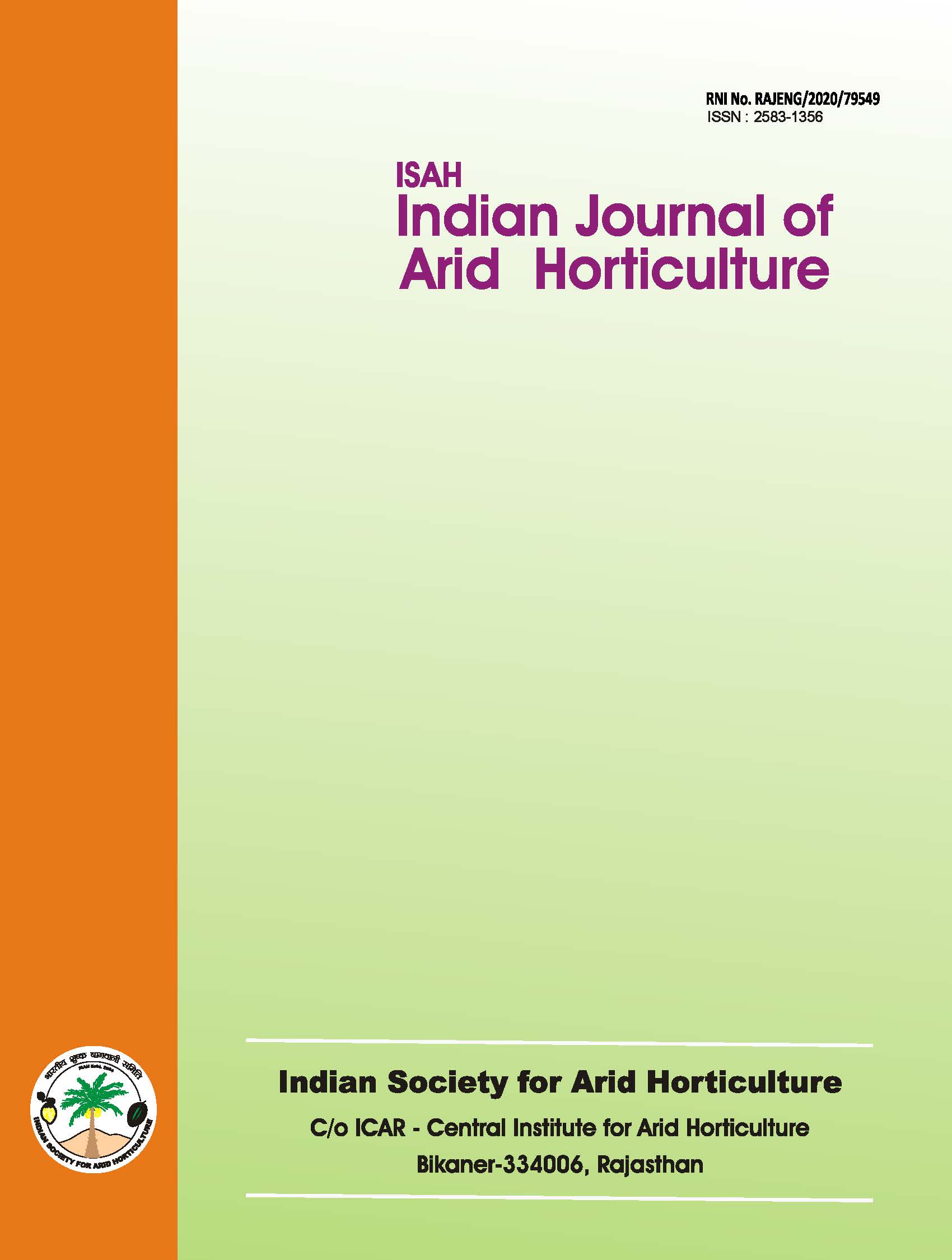Changes in physico-chemical composition of pomegranate fruits during growth and development under arid ecosystem
Keywords:
pomegranate, fruit growth, development, composition, maturityAbstract
The fruits of pomegranate variety "Mridula" showed double sigmoid pattern of growth and development. The length, diameter, volume and weight of fruit indicated two phases of growth: a rapid phase until 30-90 days after anthesis and there after a gradual phase until harvest. With the advancement of the fruit maturity, the percentage of the arils and aril rind ratio increases, whereas, percentage of rind and its thickness decreased continuously throughout the growth period of the fruit. Total soluble solids, TSS: acidity ratio, reducing and non reducing sugars and ascorbic acid content of the fruits increased with advancement of fruit maturity, whereas acidity after little increase in the beginning, gradually decreased with growth and development. For best dessert quality and profitable marketing fruits of pomegranate var. 'Mridula" under arid ecosystem can be harvested 120-150 days after anthesis.Downloads
References
Al Maiman, S. A. and Ahmad, D. 2002. Changes in physical and chemical properties during pomegranate (Punica granatum L.) fruit maturation. Food Chemistry, 76: 437-441.
AOAC. 2000. Official Methods of Analysis. Assoc. of Official Analytical Chemists (17th edn.), Ed. Horwitz, Maryland, USA.
Ben Arie, R., Segal, N., and Guelfa Reich, S. 1984. The maturation and ripening of the 'Wonderful' pomegranate. J. Amer. Soc. Hort. Sci., 109: 898-902.
Commbe, B. G. 1976. The development of fleshy fruits. Ann. Rev. Plant Physiol., 27: 207-228.
Dhandhar, D. G. and Singh, D. B. 2002. Current status and future needs for the development of pomegranate. In: Proceedings of National Horticulture Conference held during 18-19 October 2002, organized by Dept. of Agric. and Co-operation, Min. of Agric., N. Delhi.
Fahn, A. 1974. Plant Anatomy. Pergamon Press Inc., Oxford, UK. Pp. 611.
Fond, M. M., Barkat, M. R., and Elvazal, S. A. 1979. Bud burst activity, flowering, and fruit set of Dela Grenomillere and Manfoloti pomegranate cultivars under Giza conditions. Research Bulletin, Faculty of Agricultural, Ain Shems University, pp. 17.
Hayes, W. B. 1957. Fruit Growing in India. Kitabistan, Allahabad, India. 502p.
Khodade, M. S., Warhat, K. N., and Kalo, P. N. 1990. Physico-chemical changes during growth and development of pomegranate fruit. Indian J. Hort., 47(1): 21-27.
Malhotra, V. K., Khajuria, H. N., and Jawanda, J. S. 1983.
Mirdehghan, S. H. and Rahemi, M. 2006. Changes in physico-chemical attributes of pomegranate during fruit growth and development. Indian J. Hort., 63(2): 122-125.
Patil, A. V. and Karale, A. R. 1990. Pomegranate. In: Fruits: Tropical and Subtropical (Eds., Bose, T.K. and Mitra, S.K.), Naya Prakash Publications, Kolkata.
Rangana, G. S. 1986. Manual of Analysis of Fruit and Vegetable Products. Tata McGraw Hill Publishing Co. Pvt., New Delhi.
Shulman, Y.L., Fainberstein, and S. Lavee. 1984. Pomegranate fruit development and maturation. J. Hort. Sci., 59(2): 265-274.
Singh, D. B. and Kingsly, A. R. P. 2007. Regulation of Bahar in pomegranate (Punica granatum) to control fruit cracking and improve the quality. Indian Journal of Agricultural Sciences, 77(10): 692-694.

